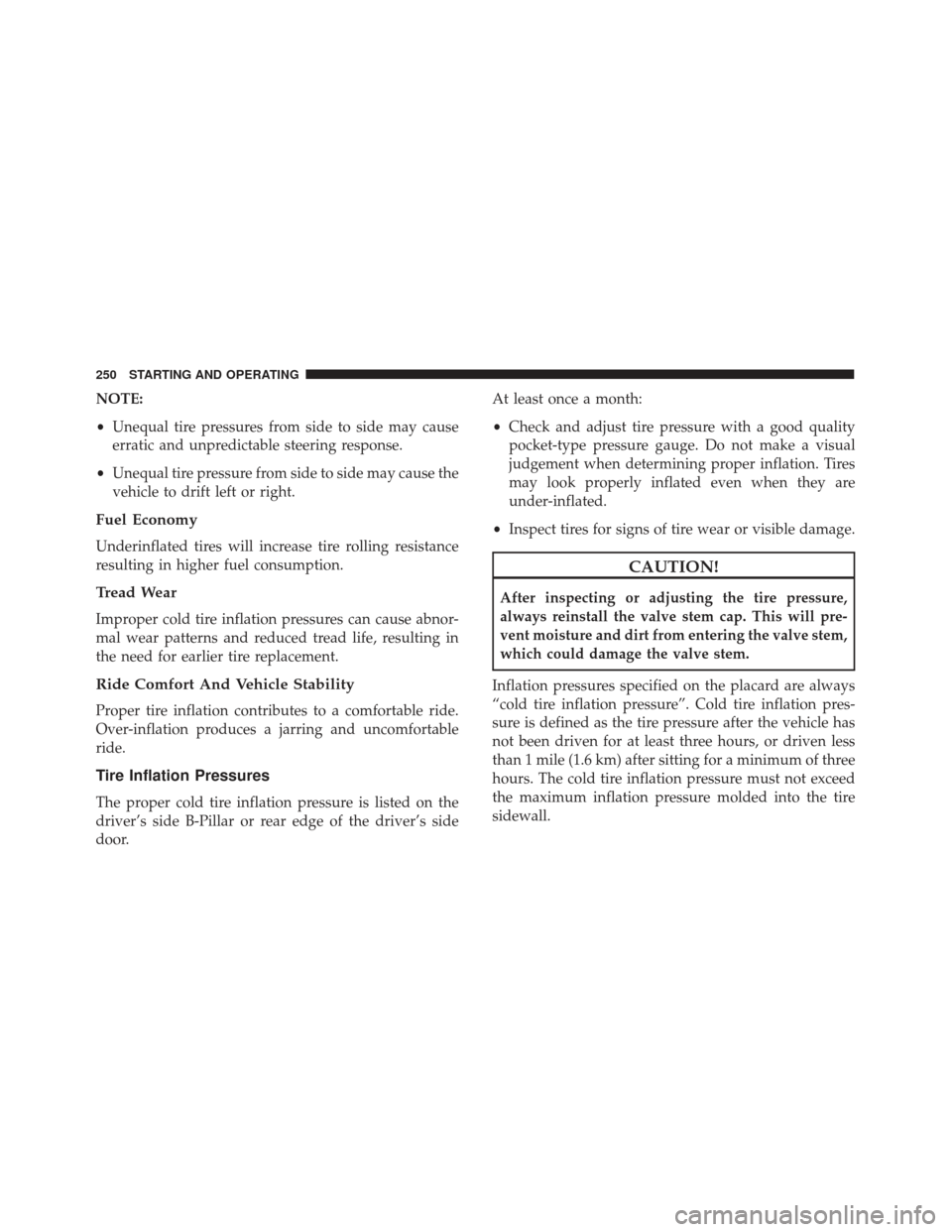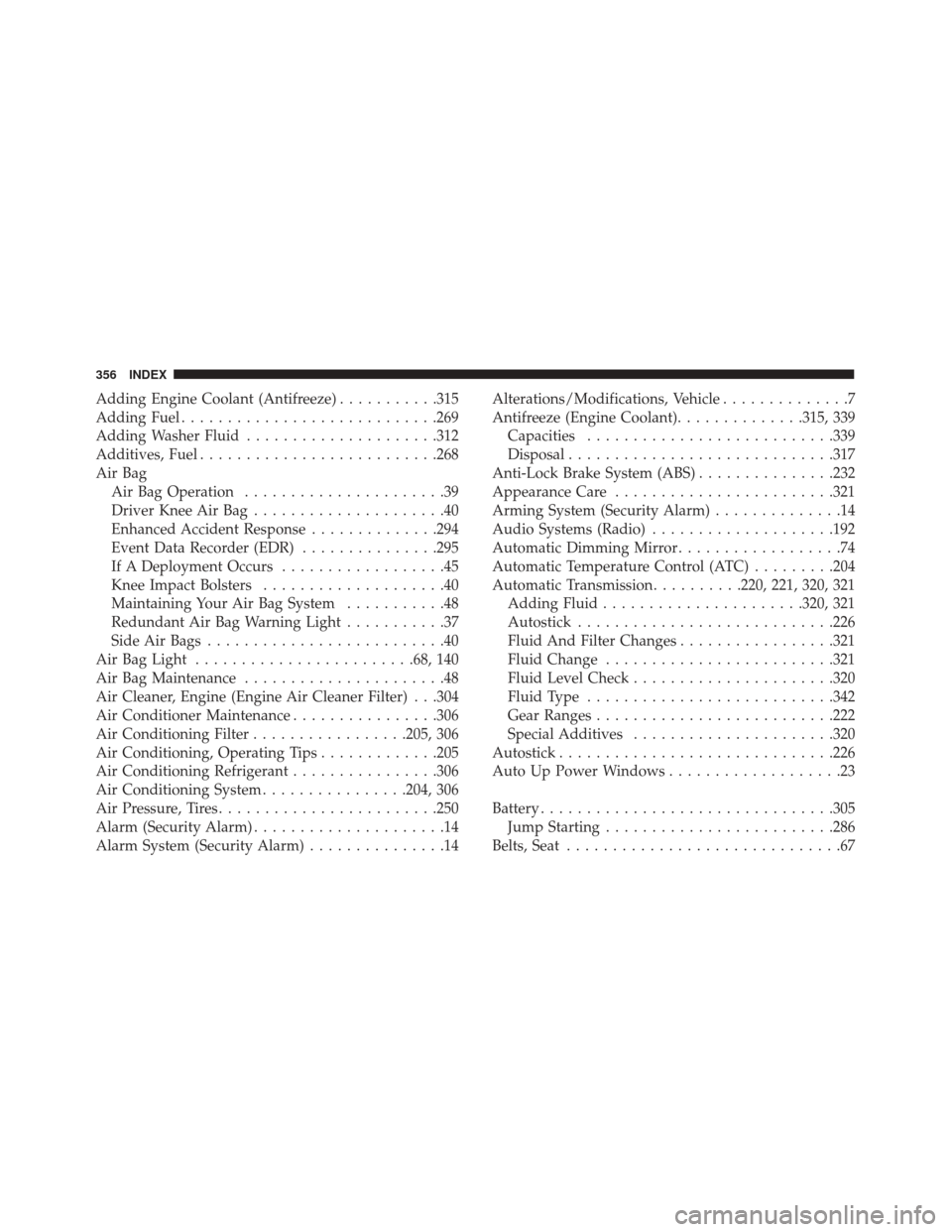2017 FIAT 500L fuel pressure
[x] Cancel search: fuel pressurePage 252 of 370

NOTE:
•Unequal tire pressures from side to side may cause
erratic and unpredictable steering response.
• Unequal tire pressure from side to side may cause the
vehicle to drift left or right.
Fuel Economy
Underinflated tires will increase tire rolling resistance
resulting in higher fuel consumption.
Tread Wear
Improper cold tire inflation pressures can cause abnor-
mal wear patterns and reduced tread life, resulting in
the need for earlier tire replacement.
Ride Comfort And Vehicle Stability
Proper tire inflation contributes to a comfortable ride.
Over-inflation produces a jarring and uncomfortable
ride.
Tire Inflation Pressures
The proper cold tire inflation pressure is listed on the
driver’s side B-Pillar or rear edge of the driver’s side
door. At least once a month:
•
Check and adjust tire pressure with a good quality
pocket-type pressure gauge. Do not make a visual
judgement when determining proper inflation. Tires
may look properly inflated even when they are
under-inflated.
• Inspect tires for signs of tire wear or visible damage.
CAUTION!
After inspecting or adjusting the tire pressure,
always reinstall the valve stem cap. This will pre-
vent moisture and dirt from entering the valve stem,
which could damage the valve stem.
Inflation pressures specified on the placard are always
“cold tire inflation pressure”. Cold tire inflation pres-
sure is defined as the tire pressure after the vehicle has
not been driven for at least three hours, or driven less
than 1 mile (1.6 km) after sitting for a minimum of three
hours. The cold tire inflation pressure must not exceed
the maximum inflation pressure molded into the tire
sidewall.
250 STARTING AND OPERATING
Page 265 of 370

(20°C) and the measured tire pressure is 27 psi (186
kPa), a temperature drop to 20°F (-7°C) will decrease
the tire pressure to approximately 23 psi (159 kPa). This
tire pressure is sufficiently low enough to turn on the
Tire Pressure Monitoring Telltale Light. Driving the
vehicle may cause the tire pressure to rise to approxi-
mately 27 psi (186 kPa), but the Tire Pressure Monitor-
ing Telltale Light will still be on. In this situation, the
Tire Pressure Monitoring Telltale Light will turn off only
after the tires are inflated to the vehicle’s recommended
cold tire pressure value.
CAUTION!
•The TPMS has been optimized for the original
equipment tires and wheels. TPMS pressures and
warnings have been established for the tire size
equipped on your vehicle. Undesirable system
operation or sensor damage may result when
using replacement equipment that is not of the
same size, type, and/or style. Aftermarket wheels
can cause sensor damage. Using aftermarket tire
sealants may cause the Tire Pressure Monitoring
System (TPMS) sensor to become inoperable.
(Continued)
CAUTION! (Continued)
After using an aftermarket tire sealant it is recom-
mended that you take your vehicle to an autho-
rized dealership to have your sensor function
checked.
• After inspecting or adjusting the tire pressure,
always reinstall the valve stem cap. This will
prevent moisture and dirt from entering the valve
stem, which could damage the Tire Pressure
Monitoring Sensor.
NOTE:
• The TPMS is not intended to replace normal tire care
and maintenance, or to provide warning of a tire
failure or condition.
• The TPMS should not be used as a tire pressure
gauge while adjusting your tire pressure.
• Driving on a significantly under-inflated tire causes
the tire to overheat and can lead to tire failure.
Under-inflation also reduces fuel efficiency and tire
tread life, and may affect the vehicle’s handling and
stopping ability.
5
STARTING AND OPERATING 263
Page 305 of 370

when the reading is at the low end of the indicated
range will result in the oil level at the full end of the
indicator range.
CAUTION!
Do not overfill the engine with oil. Overfilling the
engine with oil will cause oil aeration, which can
lead to loss of oil pressure and an increase in oil
temperature. This loss of oil pressure and increased
oil temperature could damage your engine.
Change Engine Oil
The oil change indicator system will remind you that it
is time to take your vehicle in for scheduled mainte-
nance. Refer to the “Maintenance Schedule” for further
information.
NOTE:Under no circumstances should oil change
intervals exceed 10,000 miles (16,000 km), twelve
months or 350 hours of engine run time, whichever
comes first. The 350 hours of engine run or idle time is
generally only a concern for fleet customers.
Engine Oil Selection
For best performance and maximum protection for
turbocharged engines under all types of operating
conditions, the manufacturer recommends synthetic
engine oils that are API Certified and meet the require-
ments of FCA Material Standard MS-12991.
Engine Oil Viscosity — 1.4L Turbo Engine (SAE
Grade)
MOPAR SAE 5W-40 full synthetic engine oil is recom-
mended for all operating temperatures. This engine oil
improves low temperature starting and vehicle fuel
economy.
Lubricants which do not have both the engine oil
certification mark and the correct SAE viscosity grade
number should not be used.
The engine oil filler cap also shows the recommended
engine oil viscosity for your engine. For information on
engine oil filler cap location, refer to “Engine Compart-
ment” in “Maintaining Your Vehicle” for further infor-
mation.
7
MAINTAINING YOUR VEHICLE 303
Page 358 of 370

Adding Engine Coolant (Antifreeze)...........315
Adding Fuel ............................269
Adding Washer Fluid .....................312
Additives, Fuel ..........................268
Air Bag Air Bag Operation ......................39
Driver Knee Air Bag .....................40
Enhanced Accident Response ..............294
Event Data Recorder (EDR) ...............295
If A Deployment Occurs ..................45
Knee Impact Bolsters ....................40
Maintaining Your Air Bag System ...........48
Redundant Air Bag Warning Light ...........37
Side Air Bags ..........................40
Air Bag Light ........................68, 140
Air Bag Maintenance ......................48
Air Cleaner, Engine (Engine Air Cleaner Filter) . . .304
Air Conditioner Maintenance ................306
Air Conditioning Filter .................205, 306
Air Conditioning, Operating Tips .............205
Air Conditioning Refrigerant ................306
Air Conditioning System ................204, 306
Air Pressure, Tires ........................250
Alarm (Security Alarm) .....................14
Alarm System (Security Alarm) ...............14Alterations/Modifications, Vehicle
..............7
Antifreeze (Engine Coolant) ..............315, 339
Capacities .......................... .339
Disposal ............................ .317
Anti-Lock Brake System (ABS) ...............232
Appearance Care ........................321
Arming System (Security Alarm) ..............14
Audio Systems (Radio) ....................192
Automatic Dimming Mirror ..................74
Automatic Temperature Control (ATC) .........204
Automatic Transmission ..........220, 221, 320, 321
Adding Fluid ..................... .320, 321
Autostick ............................226
Fluid And Filter Changes .................321
Fluid Change ........................ .321
Fluid Level
Check ..................... .320
Fluid Type .......................... .342
Gear Ranges ..........................222
Special Additives ..................... .320
Autostick ............................. .226
Auto Up Power Windows ...................23
Battery ............................... .305
Jump Starting ........................ .286
Belts, Seat ..............................67
356 INDEX
Page 363 of 370

Keyless Enter-N-GoLock The Vehicle’s Doors .................183
Passive Entry Programming ...............183
Unlock Liftgate ........................183
Key, Replacement .........................14
Keys ..................................11
Key, Sentry (Immobilizer) ...................13
Lane Change Assist .......................92
Lap/Shoulder Belts ........................29
Latches ................................70
Lead Free Gasoline .......................266
Leaks, Fluid .............................70
Life Of Tires ............................257
Liftgate (Sedan) ..........................24
Light Bulbs ..........................70, 334
Lighter, Cigar ...........................119
Lights ............................70, 90, 91
AirBag...........................68, 140
Brake Assist Warning ...................236
Brake Warning ........................137
Bulb Replacement ..................... .336
Center Mounted Stop ...................339
Cruise ............................. .151
Engine Temperature Warning ..............139Exterior
..............................70
Low Fuel ............................145
Malfunction Indicator (Check Engine) ........146
Park ............................ .92, 150
Passing ..............................91
Seat Belt Reminder .....................139
Security Alarm .........................14
Service ............................. .336
Tire Pressure Monitoring (TPMS) ...........147
Traction Control .......................236
Turn Signal ........................70, 150
Warning (Instrument Cluster Description) . .139, 150
Loading Vehicle Tires ...............................245
Locks Child Protection ........................21
Door ................................19
Lubrication, Body ....................... .309
Lug Nuts ............................. .275
Maintenance
Free Battery ...................305
Maintenance, General .....................302
Maintenance Procedures ...................302
Maintenance Schedule .....................344
Malfunction Indicator Light (Check Engine) .....146
10
INDEX 361
Page 364 of 370

Manual, Service........................ .353
Master Cylinder (Brakes) ...................318
Methanol ............................. .267
Mirrors ................................74
Automatic Dimming .....................74
Electric Powered .......................76
Electric Remote ........................76
Heated ..............................77
Rearview .............................74
Modifications/Alterations, Vehicle ..............7
Monitor, Tire Pressure System ...............262
MTBE/ETBE .......................... .267
Multi-Function Control Lever ................91
New Vehicle Break-In Period .................65
Occupant Restraints .......................26
Octane Rating, Gasoline (Fuel) ...............266
Oil Change Indicator ..................... .154
Oil Change Indicator, Reset .................154
Oil, Engine ..................... .302, 339, 340
Capacity ............................339
Change Interval .......................303
Checking ............................302
Disposal ............................ .304Filter
...............................304
Filter Disposal ........................304
Materials Added To ....................304
Pressure Warning Light ..................140
Recommendation ...................303, 339
Viscosity ............................303
Oil Filter, Change ........................304
Oil Filter, Selection .......................304
Oil Pressure Light ........................140
Onboard Diagnostic System .................300
Opener, Garage Door (HomeLink) ............110
Operating Precautions .....................300
Operator Manual (Owner’s Manual) ............4
Overheating, Engine ..................... .274
Owner’s Manual (Operator Manual) .........4,353
Paint Care ............................ .321
Parking Brake.......................... .230
ParkSense
System, Rear ....................103
Passing Light ............................91
Placard, Tire And Loading Information ......245, 246
Power Mirrors ..............................76
Sunroof .............................117
Windows .............................22
362 INDEX